Hungary 1956
Published in 20th-century / Contemporary History, Features, Issue 3 (May/Jun 2006), Volume 14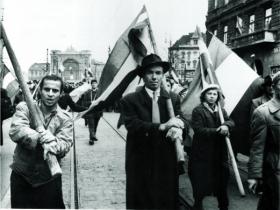
Factory workers marching in Budapest. (Erich Lessing, Magnum).
In the autumn and winter of 1956 a popular mass movement rose up against the ruling communist dictatorship in Hungary and sought to introduce a multi-party democracy and to take the country out of its military alliance with the Soviet Union. For a few heady days it seemed that this movement would be successful, as popular support for the revolution grew and occupying Soviet troops showed signs of withdrawing from the country. By the end of the year, however, the revolution had been suppressed by Soviet military intervention, its leaders had been arrested, and a new Hungarian communist government, loyal to the Soviet Union, had been put in place.
Despite its ultimate failure, the Hungarian Revolution nevertheless marked a turning-point in the history of Europe. It was the first, and arguably the only, attempt at the revolutionary overthrow of a ruling communist party and the whole system of political and economic institutions that went with it. Before the Hungarian Revolution there had been protests or uprisings against communist rule that had been put down by force, for example in East Berlin in 1953, and in the Polish city of Pozna´n in 1956. Indeed, events in Poland during 1956 nearly provoked Soviet military intervention there, but an agreement was reached that allowed a Polish communist government to come to power with its own set of policies that were not so closely tied to those of the Soviet Union. However, even in Poland a widespread mass challenge to the authorities did not emerge in the way it did in Hungary. Support for the revolution came from all parts of Hungary—the capital, Budapest, and all provincial areas—and from almost all shades of political opinion, from reformist elements within the communist party to members of opposition parties that the communists had banned, and people with no particular politics at all.
What marked the Hungarian events in particular was the deep-rooted nature of the movement that emerged rapidly in almost all sections of society. We might see the Hungarian Revolution as a series of separate and intertwining revolutions, with different political groups emerging to represent the interests and ambitions of different sections of society, ranging from reformist politicians within the communist party, to intellectuals, students, organised industrial workers, and young people and apprentices who took to the streets of Budapest in the autumn of 1956. The interests and outlooks of each group differed and, as the revolution developed, different groups came to the fore, leading to a gradual radicalisation of the aims and demands, posing an ever greater challenge to the interests of the Soviet Union.
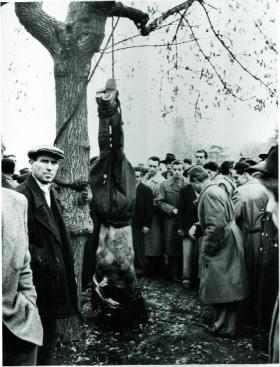
A secret police colonel hanged by the feet. (Erich Lessing, Magnum)
The roots of the revolution
The discontents that spilled over into the revolutionary events of 1956 had their origins in the way communist power was imposed on Hungary in the late 1940s. Opposition political parties were banned and their leaders were either arrested or encouraged to join a popular front movement under communist leadership. Strict censorship of the media was introduced and freedom of expression was severely limited. As communist power became dominant, arrests and executions of opposition figures became more common, large sections of the Budapest middle class were forcibly removed to the countryside, and community leaders and professionals across the country were forced out of their positions and often arrested. Ultimately, mirroring events in Stalin’s Soviet Union, the communist leadership, under Mátyás Rákosi, turned on their own party comrades, accusing them of treason and staging show trials of the most prominent ‘revisionists’ such as Lászlo Rajk, the former underground resistance leader of the early 1940s.
Within a few years the Soviet model of economic and political institutions was imposed on Hungary. All significant areas of economic life were brought under public ownership and direct state management. The communists established their own monopoly in political life; all rival parties were banned, and similarly all independent organisations of civil society were either banned or incorporated into the bureaucratic structures of the state or the ruling party. Following the Soviet model of economic management, priority was given to the needs of heavy industry, while light industry and the supply of consumer goods and services were neglected. Industrial workers were put under severe pressure to meet unrealistic production targets. Small family farmers, who had only just benefited from a land reform after the end of World War II, were now required to give up their independent farming and join collective farms following the Soviet model. The outcome was a severe disruption of the economy and a decline in living standards. Real wages fell by 18% between 1949 and 1952, and passive resistance by farmers against collectivisation led to increasing food shortages. The introduction of the rationing of groceries in 1951 sparked off a number of protest strikes in factories.
Until 1953, despite a stagnating economy and rising discontent, the communist government maintained its severely repressive hold on Hungary, in line with the requirements laid down by Stalin’s leadership in the Soviet Union. However, following Stalin’s death in 1953, communist leaderships across Eastern Europe were placed in a much more uncertain position regarding exactly how to interpret the Soviet lead they were expected to follow. As ‘conservatives’ and ‘reformers’ struggled for power in the Soviet Union, they each encouraged their own followers among East European political leaders, and the fortunes of each group rose and fell according to Soviet developments. In Hungary this led initially to the promotion of a reforming communist politician, Imre Nagy (pronounced Nodj), to the post of prime minister in July 1953.
Nagy’s ‘New Course’ policy included encouragement of the production of food and consumer goods and a relaxation of the collectivisation campaign in the countryside. Victims of the purges and show trials were released from prison, and some writers and intellectuals began to push against the constraints of censorship and to take a more independent view. However, during 1954 and 1955, again following Soviet developments, the Stalinist elements in the communist leadership became stronger, leading to the dismissal of Nagy in April 1955. The uncertainty was only ended by Soviet leader Khrushchev’s so-called ‘Secret Speech’ of February 1956, in which he denounced many aspects of Stalin’s leadership. As its contents became known, this gave a boost to the communist reformers and led to a period of intense jostling for power during the following months.
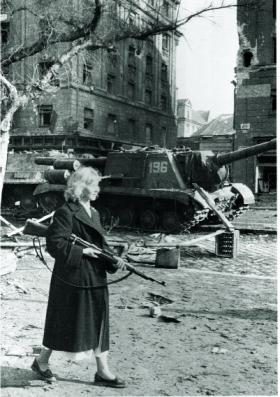
A female resistance fighter after the first battle. (Rolf Gillhausen, Stern).
The emergence of a protest movement
In the context of the struggle for power at the top of the party-state and the confusion over which policy line would prevail, a support base for Imre Nagy and his ‘New Course’ gradually grew within communist party circles. At this stage the ruling party’s control over society was still too strong for any opposition outside the party to mobilise. Many party intellectuals and professionals, including writers and artists, journalists, teachers, engineers and technical experts, lent their support to the reform side of the debate within the party—even though, if the Stalinist wing was successful, it would mean the loss of their jobs, or worse. Reform ideas also gained ground among young people and students through the framework of the communist youth organisation, DISZ. The first open sign of opposition to the hard line came in the autumn of 1955, when a group of writers and artists dared to make a public criticism of the authorities by signing ‘The Writers’ Memorandum’, denouncing the official restrictions on the performance of plays and concerts by some leading writers and composers of the pre-communist period.
By the spring of 1956, with rumours of Khrushchev’s ‘Secret Speech’ beginning to leak beyond the leadership circles of the ruling party, a group of intellectuals began to meet under the framework of DISZ and to hold increasingly daring discussions on a wide range of issues in literature, economics, history and ideology. Known as the Petõfi Circle (after the nineteenth-century poet Sándor Petõfi, who had been a leading figure in Hungary’s movement for independence from the Hapsburg empire in 1848), their meetings attracted increasing public interest, culminating in their discussion on the press in June 1956, when a crowd of 7,000 gathered in the street outside the meeting hall and listened to the debate broadcast through loud-speakers. Following the Polish uprising in Pozna´n the following day, the Hungarian leadership became nervous of the growing public mood in Budapest and ordered the Petõfi Circle to suspend its activities. By now, however, a momentum for change was growing and proving difficult to suppress. By the autumn university students were setting up their own independent organisations outside party control and organising their own debates, similar in scope to those of the Petõfi Circle.
Meanwhile, through the summer and early autumn of 1956 Hungarians were watching events in Poland with avid interest. While Hungary was still under the rule of the Stalinist leadership of Rákosi, the Polish communists elected a reformist, Wladyslaw Gomulka, whose ideas reminded them of the ousted Imre Nagy. To begin with, the Soviet leadership refused to recognise Gomulka and threatened military intervention in Poland. However, by 20 October they finally conceded to the Polish party’s decision and Gomulka was confirmed as first secretary (i.e. leader) of the party on 21 October..
Partly inspired by the Polish events and partly developing according to their own momentum, the Hungarian student movement now began to make public demands for reform. Their goals incorporated those of Nagy but rapidly moved beyond them: echoing the aims of the 1848 revolutionaries, they also called for civil rights, a multi-party parliamentary democracy, national independence and the withdrawal of Soviet troops.
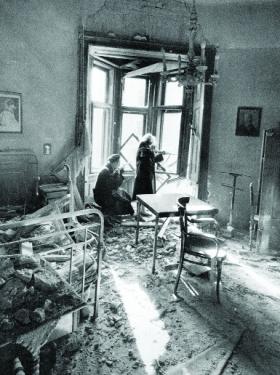
Revolutionaries shooting from the window of a destroyed flat. (Rolf Gillhausen, Stern)
From protest to uprising
Alarm bells began to ring even more urgently in government circles when students held a large demonstration on 22 October at the Budapest Technical University on the Buda side of the River Danube. This prompted the government to ban further demonstrations, but this order was ignored and an even bigger demonstration was held the next day, 23 October, with students from the Technical University being joined by those from the Arts Faculty on the Pest side of the city. Marches from each university met at the statue of General Bem, another hero of the 1848 rising. Joined by supporters of the Petõfi Circle and the Writers’ Union, the demonstrators repeated the demands drawn up the previous day and called for them to be broadcast on the radio. That evening the demonstrators left Bem Square and spread out to protest at various locations in Budapest. Around 200,000 gathered outside the parliament building and called for Imre Nagy to speak, others congregated at the statue of Stalin near the City Park, while yet others went to the radio headquarters to call for their demands to be broadcast. Events then became very confused. Nagy tried to calm the situation by calling for the crowd outside parliament to disperse so that a negotiated settlement could be reached within the party leadership. The demonstrators responded to his call, but not without considerable disappointment and anger. However, the situation became much more radical at the other protest locations: while one crowd pulled down Stalin’s statue, the other tried to storm the radio building.
The government remained determined that the protesters’ demands would not be broadcast, and sent troops and secret policemen to defend the radio station. At this point some of the defenders fired on the crowd in an effort to force them back. With this act the situation changed rapidly from a radical protest into an armed uprising. Some of the demonstrators soon obtained guns of their own (either from some of the soldiers sent to defend the radio station or from a local barracks nearby) and stormed the building. On 24 October the government declared a state of emergency and requested the intervention of Soviet troops. Over the next few days there was fierce fighting between Soviet forces and Hungarian secret police on one side and small, armed bands of street fighters on the other.
During this period the main dynamic force of the revolution moved from the students and intellectuals to teenagers and young workers, male and female, many of them living in poor conditions in workers’ barracks in the city. Relatively few of the street fighters were older than twenty or had higher education. A few members of the Hungarian army fought alongside them, but for the most part they stayed out of the fighting, along with the ordinary police. Although the street fighters only numbered a few thousand, they had the support of much wider sections of the population, many of whom helped to feed and sustain them.
The revolution deepens
Inspired by events in Budapest, the revolution rapidly became a nationwide movement and took root among a much wider cross-section of the population. In provincial cities and the countryside school and college students drew up their own lists of demands, demonstrations were held, and symbols of Soviet influence such as statues of Stalin were pulled down. Although there was relatively little violence, the authority of the communist local leaders soon crumbled. Local people across Hungary first elected delegates to negotiate with the authorities, but soon moved to set up their own self-governing bodies to run local affairs. At this point many factories and workplaces also formed workers’ councils to take over the running of their work from the communist managers. In the countryside revolutionary committees dissolved collective farms and set about organising food supplies for the struggle in the cities.
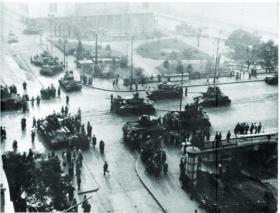
Soviet tanks in Budapest. (Keystone Press)
The rapid spread and deepening of the revolution had an impact in turn on the thinking of the communist leaders. To begin with, the old-guard Stalinists attempted a mixture of taking a tough stand with the revolutionaries and seeking to broaden their appeal by bringing reform communists back into government. On the night of 24 October, after declaring a state of emergency, they invited Imre Nagy and two of his colleagues back into the leadership, offering Nagy the post of prime minister. As a loyal communist Nagy accepted the position, even though it meant sharing office with the Stalinists. No doubt he hoped to use his position to argue for compromise with the revolutionaries and a return to the reform policies he had promoted earlier. However, opinion in the country had shifted radically since he was last in office and it soon became clear to him that a peaceful resolution would require government acceptance of many of the demands of the revolutionaries.
The following days saw Nagy adopting ever more radical views. As a first step, following intensive debate within the communist party leadership, he announced a cease-fire on 28 October. This was followed by negotiations with Soviet leaders to secure a return of Soviet troops to barracks. In the following days Nagy succeeded in bringing more reform communists into government and announced the dissolution of the secret police. On 30 October he announced the end of single-party rule and set up a new cabinet including representatives of many of the parties that had been banned by the communists in the late 1940s. Further, it was announced that the street fighters would be invited to join a new restructured police force and that negotiations would proceed to secure the removal of all Soviet troops from Hungary. On 1 November Nagy declared Hungary’s withdrawal from the Soviet-dominated military alliance, the Warsaw Pact, and appealed to the United Nations for international recognition of Hungary’s neutrality.
Thus by the beginning of November Nagy had brought a large section of the communists into line with popular opinion and had established a broad-based popular national government to implement the demands of the revolution across the country. Just for a moment it seemed that, against all the odds, a popular grass-roots movement, developing spontaneously without any centralised leadership, had overcome the repressive communist state and the military support of its Soviet backers.
Defeat and repression
Despite appearances, however, there were already ominous signs that the gains of the revolution would not be sustained. Although the vast majority of Hungarian society was behind Nagy’s government and there were widespread expressions of popular support around the world, Western governments, distracted by the Suez crisis (in which Britain, France and Israel had invaded Egypt to prevent the nationalisation of the Suez Canal), showed no interest in offering support to a neutral Hungary. Furthermore, the initially sympathetic communist leaders in neighbouring countries, Gomulka in Poland and Tito in Yugoslavia, balked at the ideas of multi-party democracy and neutrality and withdrew their support. And despite the seeming willingness of Soviet representatives to discuss troop withdrawals, Soviet reinforcements were being sent to Hungary. A fatal split also emerged in the Hungarian communist leadership. On 1 November two communist government members, János Kádár and Ferenc Münnich, had been flown to Russia for talks with Soviet leaders. In the early hours of 4 November Budapest was attacked by sixteen Soviet divisions, the Hungarian army was disarmed, and Kádár was flown back to head a new Soviet-backed Hungarian communist government.
The Soviet army was met with fierce resistance from armed groups as it tried to secure its hold over Budapest but, against overwhelming odds, the street fighters could do little to resist the Soviet onslaught. By 11 November the armed resistance was broken, although many workers’ councils continued with tactics of passive resistance, strikes and non-cooperation until well into 1957. The defeat led to a flood of refugees across the western border with Austria. In all, over 200,000 people, or 2% of the total population of Hungary, left the country.
After the installation of Kádár’s government there followed a period of severe repression. Initially, Nagy and several colleagues were given asylum in the Yugoslav embassy in Budapest, but on 22 November they were tricked by false promises of safe conduct into leaving the embassy. They were arrested and smuggled out of the country to Romania, where they were held in prison. They were finally put on trial in the summer of 1958. Nagy and several colleagues were sentenced to death and executed, while others were given long prison sentences. Leaders of the street fighters were dealt with more rapidly—many were tried on criminal charges in early 1957 and sentenced to death. Several workers’ council leaders were also sentenced to death, along with some army officers who had joined the resistance. Other workers’ leaders and most politicians outside the group closest to Nagy were given life imprisonment or other long prison sentences. In all, 35,000 people were arrested; 22,000 were convicted, 13,000 of whom were interned; and 350 people were executed, 75% of whom were young street fighters.
The significance of 1956
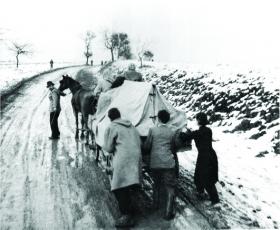
Refugees arriving at the Austrian border. (Rolf Gillhausen, Stern)
The Hungarian Revolution was the first event to clearly show the limits of what the Soviet communist leadership would tolerate within its sphere of influence in Eastern Europe. While some modest reforms of the economic system might be tolerated, the removal of the communists’ monopoly of political power and the declaration of neutrality were unacceptable. After 1956 communist rulers were confronted by two further mass challenges to their system of rule, in the ‘Prague Spring’ of 1968 in Czechoslovakia and in the rise of the Solidarity movement in Poland, beginning in 1980 and continuing in different forms throughout the following decade. However, perhaps in an attempt to learn from the Hungarian experience, neither the Czechoslovak nor the Polish movement attempted such a root-and-branch rejection of the Soviet system as the Hungarian Revolution did. While the Czechoslovak reform communist leadership aimed to create a ‘communism with a human face’, the Polish Solidarity movement aimed at a ‘self-limiting revolution’ that did not attempt to take state power from the communists. Nevertheless, their more modest aims did not prevent their suppression by military force, Soviet intervention in Czechoslovakia and home-grown martial law in Poland.
Despite its failure, the Hungarian Revolution of 1956 remains an event of great historical interest. Somehow people were able to mobilise and form a mass movement against the state in conditions where all independent forms of political activity and free expression had been suppressed. Since there was no opposition political party, or even an underground conspiratorial leadership, the movement developed from the grass roots. As the revolution developed, the leadership that emerged under Imre Nagy was constantly revising its stand to take account of the views of different social groups, whether it was the students, the street fighters or finally the workers’ councils.
The Hungarian Revolution was also notable in that it was predominantly a socialist movement fighting against a communist state. Unlike the political groups that were ultimately to succeed the communists after 1989, there was little support in 1956 for the restoration of a capitalist economic system. Although the collectivisation of agriculture was unpopular, very few wanted to see the privatisation of industry or the banks. Instead, a strong current within the movement, led by the workers’ councils, wanted to keep public ownership of the economy but decentralise its management to workers’ councils.
Finally, as a mass movement with widespread popular support from almost all sections of its society, the Hungarian Revolution called into question, more clearly than any event before, the official claims of the communist leaders of Eastern Europe that they were popular movements representing the interests of ordinary working people. In this sense 1956 can be seen as the beginning of the long process of the erosion of communist rule in Eastern Europe that ended in its fall from power in 1989.
Terry Cox is professor of Central and East European Studies at the University of Glasgow.
Further reading:
T. Cox (ed.), Hungary 1956: forty years on (London, 1997).
G. Ekiert, The state against society: political crises and their aftermath in east central Europe (Princeton, 1996).
G. Litvan (ed.), The Hungarian Revolution of 1956 (London, 1996).
















